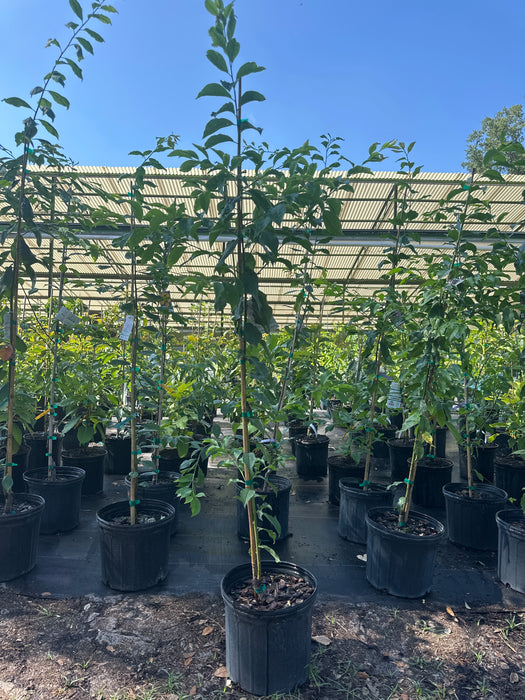
Plum Scarlet Beauty
Original price
$89.00
-
Original price
$195.00
Original price
$89.00
$89.00
-
$195.00
Current price
$89.00
Please note, Gulf plum trees are best planted in pairs with another Gulf Plum variety to assist with cross pollination of the trees. So for maximum fruit production also plant a Gulf Blaze Plum tree or a Gulf Rose Plum tree.
-
The Scarlet Beauty plum tree, a Japanese-American hybrid (Prunus salicina x Prunus americana), is a low-chill cultivar developed for warm climates, offering sweet, juicy fruit and adaptability to mild-winter regions. Known for its early ripening and vibrant red fruit, it’s a favorite for home gardeners in the southeastern United States and similar climates. Below is a comprehensive guide to its characteristics and cultivation requirements.Taste
-
Scarlet Beauty plums are celebrated for their sweet, juicy flesh with a mild tartness, particularly in the skin, which balances the flavor profile.
-
The fruit has deep red to purple skin and yellow to reddish flesh, offering a tender, succulent texture ideal for fresh eating, baking, or processing into preserves.
-
Ripening in early to mid-summer (typically late May to early June in warmer regions), the plums are best when fully ripened on the tree, achieving peak sweetness and flavor.
Best Growing Environment-
Climate: Scarlet Beauty thrives in warm, subtropical climates with low chill requirements (150–200 hours below 45°F), making it ideal for regions with mild winters.
-
Soil: Prefers well-drained, fertile, sandy loam soil with a slightly acidic to neutral pH of 5.5–6.5. Amending with organic matter like compost improves fertility and drainage.
-
Location: Plant on hilltops or slopes for optimal air drainage, reducing the risk of frost damage to early blooms. Avoid low-lying areas prone to frost pockets or waterlogging.
Common Names-
Primary name: Scarlet Beauty Plum
-
Alternate names: Often referred to as a low-chill plum or simply ‘Scarlet Beauty’ in nursery catalogs. It may be grouped with other Japanese-American hybrids or ‘Gulf’ series plums for its similar low-chill traits.
Average Height-
Scarlet Beauty is a semi-dwarf tree, typically reaching 12–15 feet at maturity, though pruning can maintain it at 8–12 feet for easier harvesting and management.
-
Its compact size makes it suitable for small orchards, home gardens, or even large containers with proper care.
Growth Rate-
The tree exhibits a moderate growth rate, adding 1–2 feet of new growth annually under optimal conditions.
-
It establishes quickly in the first 1–2 years and can begin bearing fruit within 2–4 years of planting, depending on care and environmental factors.
Sun Requirements-
Requires full sun, with at least 6–8 hours of direct sunlight daily to ensure robust growth, flowering, and fruit production.
-
Insufficient sunlight can lead to reduced yields, sparse foliage, and smaller, less flavorful fruit. A south- or west-facing location is ideal.
Cold Hardiness-
Hardy in USDA zones 8–10, Scarlet Beauty tolerates winter lows down to 10–20°F but is susceptible to damage from prolonged freezing or late spring frosts.
-
In colder microclimates within these zones, protective measures like mulching or wrapping the trunk with burlap can help safeguard against frost damage.
Water Requirements-
Young Trees: Water deeply 1–2 times per week during the first growing season to establish a strong root system. In sandy soils, increase frequency; in clay soils, reduce to avoid waterlogging.
-
Mature Trees: Water every 2–4 weeks during the growing season (spring through summer), ensuring consistent moisture during fruit development. Reduce or stop irrigation during winter dormancy.
-
Use drip irrigation to maintain even soil moisture without saturating the roots, which can prevent root rot.
Planting Guide-
Timing: Plant bare-root trees in early spring (late January to early March in zones 8–10) while dormant, after the last frost. Potted trees can be planted any time, though spring is preferred.
-
Site Selection: Choose a sunny, well-drained location with good air circulation. Test soil pH and amend with sulfur or lime to achieve 5.5–6.5 if needed.
-
Steps:
-
Dig a hole three times the width of the root ball and as deep as the roots.
-
Place the tree, ensuring the graft union is above soil level, and backfill with a mix of native soil and organic planting mix (e.g., compost with sand).
-
Water deeply to settle the soil, then apply a 2–3 inch layer of organic mulch, keeping it 4–6 inches from the trunk to prevent rot.
-
Space trees 10–15 feet apart to accommodate their semi-dwarf size and ensure adequate light and air circulation.
-
-
Rootstock: Use nematode-resistant rootstocks like Marianna 2624 or St. Julian A for better disease resistance and adaptability to various soils.
Fertilizing Times and Recommended Fertilizer-
Timing:
-
In USDA zones 8–10, fertilize twice annually: early March (before bud break) and early August to support growth and fruiting.
-
Avoid fertilizing after August to prevent late-season growth susceptible to frost damage.
-
-
Recommended Fertilizer: Apply a balanced organic fruit tree fertilizer (e.g., 10-10-10 or organic equivalent) with micronutrients like iron, zinc, manganese, magnesium, molybdenum, copper, and boron.
-
First Two Years: Use 1 pound of organic fertilizer or well-aged manure in March, supplemented with 1 cup of calcium nitrate in May.
-
Mature Trees: Apply 2/3 cup of calcium nitrate in March and August.
-
Conduct a soil test to identify deficiencies and adjust fertilizer accordingly. Spread fertilizer 6–8 inches from the trunk and water deeply after application.
-
-


